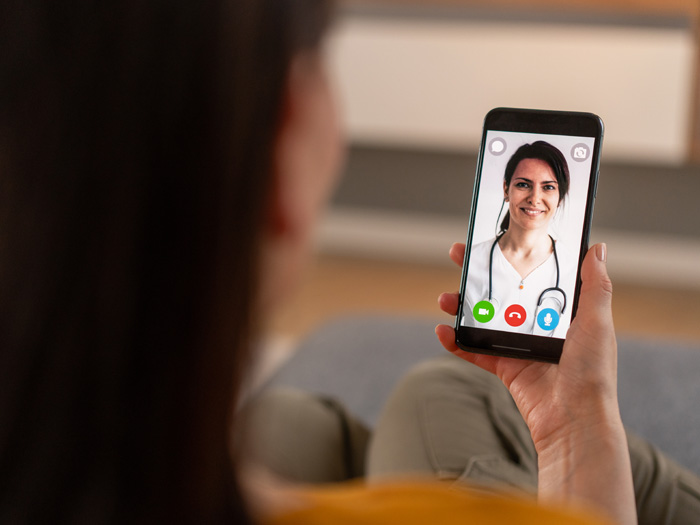Mobile Technology Is on Workers’ Comp Experts’ Minds: Here Are 3 Reasons They’re Right

In a year marked — among many areas of disruption and compromise — by a need to connect with each other virtually at nearly every touchpoint, it is unsurprising that digital and mobile solutions rank high in importance among workers’ compensation industry professionals.
In a recent survey conducted in partnership between Risk & Insurance and pharmacy & ancillary medical benefits manager Healthesystems, nearly 1 in 2 workers’ comp experts ranked mobile solutions as the most important technology impacting their organization in 2020.
While the pandemic is likely a heavy influencer of this result, given the need for many organizations to transition to a remote workforce, there is another opportunity here that pre-dates COVID.
Specifically, there is and has been a need for more digital and mobile solutions embedded into the workers’ comp claims process, especially as they relate to improving the injured worker’s experience. It is an area that has lagged woefully behind the broader health care industry, where tools such as personal apps, text communications and digital interfaces allow patients to be more directly engaged with the management of their health.
Separate from the industry survey, Healthesystems undertook a more intensive research study earlier in 2020 that was specifically designed to understand more about the workers’ compensation claims journey, pain points and opportunities to improve it through digital and mobile solutions.

Kristine Kennedy, SVP, Product Strategy and Innovation, Healthesystems
As Kristine Kennedy, SVP of product strategy and innovation at Healthesystems, explains, the study was designed to glean insights directly from injured worker patients, as well as industry professionals, to determine in what capacities and at what touchpoints mobile and digital solutions would have a positive impact in the workers’ comp claims process.
“Our research approach is focused on helping us design solutions for our industry from the outside in versus the inside out,” Kennedy said.
“It is important for us to seek to understand the pain points of our stakeholders and uncover unmet needs through user research techniques that allow us to truly get to the root of opportunities. When organizations like ours assume they know what stakeholders need, they can miss the mark. At Healthe, we have made significant investments in user research to avoid missing the mark.”
According to Healthesystems’ study, here are 3 opportunities for digital and mobile solutions to help improve the workers’ comp journey and outcomes.
1) Outdated forms of communication cause delays, claim complexity.
In the study, 1 of 4 injured workers reported experiencing complications with paperwork when initially reporting their injury. This included delays in receiving paperwork or paperwork being delivered via an inaccessible channel, such as scan or fax.
In other cases, the injured worker felt that they did not have clear steps or support during the process of reporting their injury.
How significant are these hiccups? Perhaps even more than one would expect. Astoundingly, an injured worker’s inability to complete paperwork was found to be a correlating factor to claim complexity and length, alongside more obvious red flags such as injury severity and the presence of multiple claims linked to a single injured worker.
“This is an excellent example of how research can lead you to new unmet needs. Playing this out further,” Kennedy said, “imagine a world where the experience of the injured worker is guided by artificial intelligence and smart workflows that simplify every step of their journey. Not only can we improve the satisfaction of the injured worker, we can significantly impact the overall outcomes and lessen the complexity of claims.
“It is our responsible to listen and act,” she added. “We can transform helplessness and frustration into a positive experience that makes a difference in an injured worker’s overall wellbeing. At the end of the day, they are who we are here to serve.”
2) Current interactions don’t match up with injured workers’ preferred channels.
Email and text via phone were by and far the top preferred communication channels by injured workers, with 94% using their mobile phone often and 70% regularly using text and email on their phone.
But how workers’ comp stakeholders have traditionally communicated with patients doesn’t always align with these preferences.
In addition to drilling down into what injured workers like, Healthesystems probed on what they don’t like. The findings? Snail mail contributes to the least number of helpful interactions — yet this form of communication is still frequently leveraged throughout the workers’ compensation claims process.
“It is not surprising that snail mail was ranked as one of the least helpful interactions,” Kennedy said.
“For the most part, the process of receiving lengthy documentation in the mail to digest, decipher and act on is archaic. Not to mention, it is costly and often just dismissed and thrown away. People are busy — they have many distractions, and they need simple, concise, guided solutions.
“When we talk about mobile solutions, we also need to think about the interactions and behaviors we do NOT seek to emulate,” Kennedy added. “How many robocalls do you receive and not answer? Me, I never answer them. If it is important, they will leave a message. These adjustments to current behaviors are critical to evaluate and understand. Only then will we shift the way in which we communicate to more effectively manage our interactions with the stakeholders involved, especially the injured worker.”
3) Workers’ comp can take a page from the broader health care playbook.
When probed on their most-used and most-liked mobile and digital applications for general health care services, 60% of participants reported using telehealth or virtual office visits in the 6 months prior to the study.
Medication reminders were reported as the most liked service, due to their convenience.
And patients’ ability to access information about their medical care via a digital tool rounded out the top three preferred services.
These types of digital and mobile tools translate well in workers’ compensation, where unobstructed access to care, patient engagement and motivation and medication adherence are all positive influencers on the trajectory of a claim and an injured worker’s recovery.
“The need for telehealth services has amplified,” Kennedy said, “especially over the course of this last year, and its use to connect patients with prescribing physicians only scratches the surface. There is a tremendous opportunity to expand these services to include other specialties.
“This is an area we’ve prioritized within our own program and service offerings,” she explained. “It’s exciting to bring our customers and their injured workers services that include pharmacist-to-patient medication counseling and telerehab. Being able to take a technology like telehealth and leverage it across the care continuum really supports the whole-patient approach to managing recovery and the claims process.”
Additional Perspectives
While industry participants did raise considerations that included ease of implementation within existing infrastructure and workflows, ease of use for claims staff, and cyber security requirements, the end benefits of implementing more digital and mobile solutions is an area where injured workers and industry professionals find common ground, which is of no small significance.
Fair or not, in the eyes of the injured worker, the workers’ compensation payer can be viewed as an obstacle rather than an ally.
Injured worker participants in the study reported interactions to be consistently challenging with various stakeholders at their insurance company, more so than other segments of the workers’ compensation process, such as health care providers or employers.
But as the owner of the lifecycle of a claim, workers’ compensation payers are uniquely positioned to help improve the injured workers’ experience, as well as their overall perception of the workers’ comp system.
“There are many misperceptions out there between stakeholders,” Kennedy said, “and it goes in both directions. But ultimately, a lot of it comes down to not having the infrastructure or solutions in place to be able to communicate effectively, efficiently or at the right time.
At the end of the day, while digital and mobile technologies are the conduit, it is about better connecting people with people.
“We are always looking at ways to use technology that enhance the human element of the claims journey, not replace it,” Kennedy said.
“Digital solutions provide an opportunity to interject the human element of the injured worker experience in areas where it may be lacking,” she explained, “from self-service tools that empower injured workers with information about their injury or claim, to solutions that better facilitate communication between injured workers’, insurance representatives, health care providers and other stakeholders.” &









